Are you ready for a mouthwatering showdown between two iconic dishes of Indian cuisine? Get ready to embark on a culinary adventure as we dive into the delicious world of Butter Chicken and Chicken Korma.
These two dishes have captured the hearts and taste buds of food enthusiasts around the globe with their rich flavors and distinct characteristics.
Whether you’re a fan of creamy and tangy or prefer a luxurious and mildly spiced experience, this article will guide you through the differences and similarities that make Butter Chicken and Chicken Korma stand out on the menu.
So, put on your apron, and let’s explore the clash of flavors that awaits us!
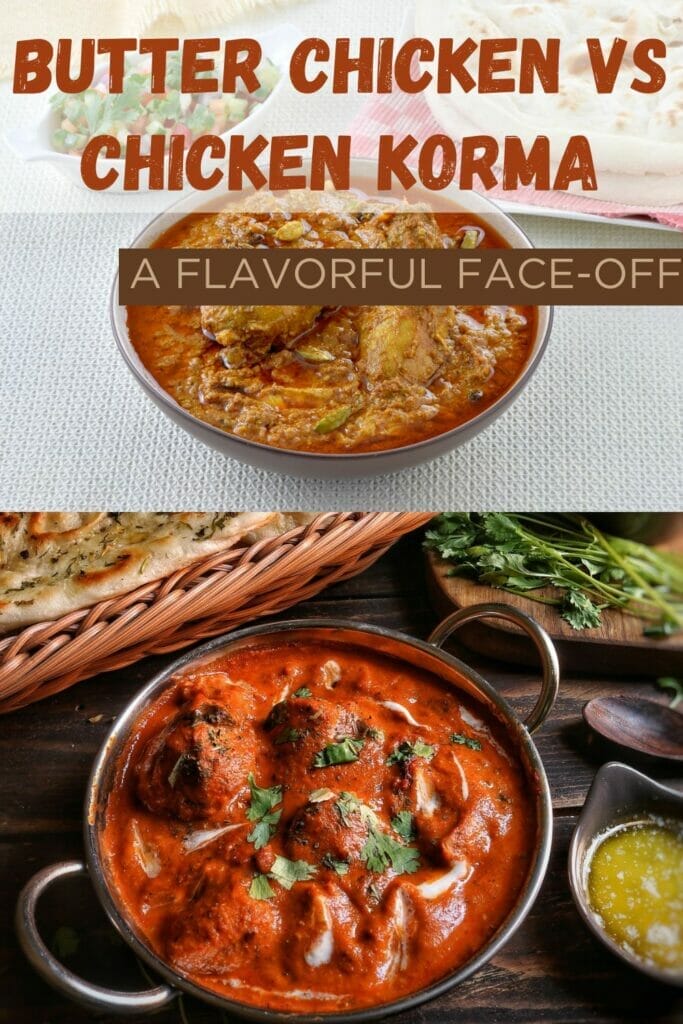
Here’s a table showing the differences in Butter chicken and Chicken korma
| Factors | Butter Chicken | Chicken Korma |
|---|---|---|
| Origin | Originated in Delhi, India | Originated in Mughal Era, India |
| Color | Vibrant reddish-orange | Creamy pale yellow or white |
| Flavor | Creamy, tangy, slightly sweet | Creamy, nutty, mildly spiced |
| Chicken Used | Boneless chicken pieces, often breast meat | Bone-in chicken, such as drumsticks or thighs |
| Texture | Tender chunks of chicken in creamy gravy | Succulent bone-in chicken in grainy sauce |
| Cooking Time | Relatively shorter (20-30 minutes) | Longer (30 minutes to over an hour) |
| Method of Cooking | Pan-frying or grilling | Slow-cooking in creamy gravy |
| Serving | Standalone dish with naan or rice | Part of a larger meal with Indian breads |
| Ingredients | Tomatoes, onions, garlic, ginger, spices, butter, cream | Yogurt, onions, ground nuts, spices |
| Nutritional Value | Calorie and fat content may vary, good source of protein | Calorie and fat content may vary, good source of protein |
A Brief Overview of Butter Chicken

Let’s kick things off with a brief introduction to butter chicken, also known as murgh makhani. This iconic dish originated in the bustling streets of Delhi and has since gained worldwide recognition. Butter chicken is a perfect blend of tender chicken, creamy tomato-based gravy, and a tantalizing blend of aromatic spices.
The chicken used in this dish is typically marinated in a mixture of yogurt and spices like ginger, garlic, and garam masala, which infuses it with incredible flavor.
After marination, the chicken is traditionally cooked in a tandoor (a traditional clay oven) to achieve a slightly smoky flavor and a tender texture. However, modern adaptations often involve cooking the chicken on a stovetop or grilling it.
Besides, you can also microwave the chicken for about 8 minutes at 250 degrees Celsius.
The rich and velvety tomato gravy in butter chicken is made by simmering tomatoes, onions, cashews, and a melange of spices until they reach a harmonious union of flavors. The addition of butter, cream, and a touch of honey lends lusciousness and a hint of sweetness to the dish. The result is a creamy, slightly tangy, and utterly delectable chicken curry that pairs perfectly with fluffy naan bread or fragrant basmati rice.
A Brief Overview of Chicken Korma

Next up, we have chicken korma, a dish that hails from the royal kitchens of India. With its roots in Mughlai cuisine, chicken korma is known for its rich, aromatic flavors and indulgent creaminess. This dish boasts a distinctive combination of spices, creating a balance that is both complex and comforting.
Chicken korma is traditionally prepared by cooking chicken pieces in a gravy made from a blend of yogurt, or ground nuts like almonds, chironji, cashews, and Birista (Fried onion flakes).
The spices used in korma can vary but the commonly used spices in the recipe include, Kashmiri laa mirch powder, coriander powder, turmeric powder, black pepper powder, garam masala powder.
Besides, korma recipe often include fragrant ingredients like cinnamon, cardamom, cloves, and nutmeg. These spices infuse the dish with a warm, inviting aroma and a depth of flavor that is simply irresistible.
The slow cooking process allows the chicken to become incredibly tender and allows the flavors to meld harmoniously.
The result is a creamy, nutty, and mildly spiced curry that satisfies both the senses and the soul. Chicken korma is often garnished with chopped fresh coriander, adding a burst of freshness to every bite.
Difference in the Origin

Let’s start by uncovering the intriguing origins of butter chicken and chicken korma. Butter chicken, or murgh makhani, was born in the vibrant streets of Delhi, India.
The recipe was born at the Moti Mahal restaurant in the Daryaganj neighbourhood of Old Delhi in the 1950s.
The recipe was invented by chance when the chef decided to reuse the leftover tandoori chicken pieces and mix them with tomato and butter gravy.
On the other hand, chicken korma has its roots in the royal kitchens of the Mughal era, where it was prepared for kings and nobles. This regal dish is known for its luxurious flavors and has been passed down through generations.
Differences in the Color
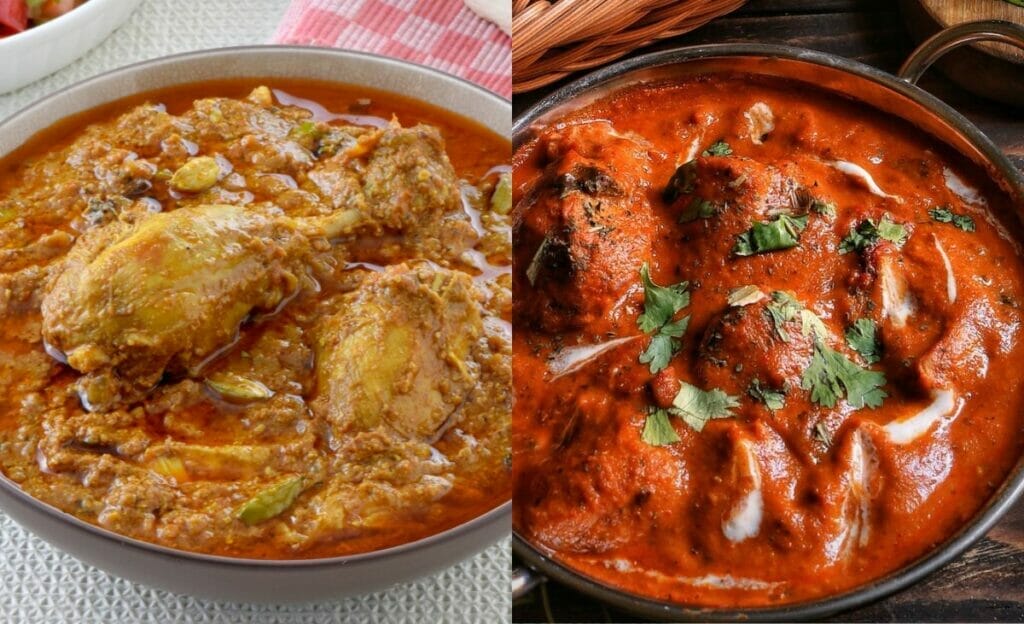
When it comes to appearances, butter chicken and chicken korma have distinct visual characteristics.
Butter chicken showcases a vibrant reddish-orange hue, thanks to the tomato-based gravy that forms the base of the dish.
The use of spices like turmeric and red chili powder adds to its rich color.
On the other hand, chicken korma flaunts a creamy, pale yellow or white shade. The creamy texture comes from the addition of ingredients like yogurt, and ground nuts, such as almonds or cashews, and shredded coconut.
Differences in Flavor

The flavor profiles of butter chicken and chicken korma set them apart in the realm of Indian cuisine.
Butter chicken boasts a delightful combination of creamy, tangy, and slightly sweet notes. The tomato-based gravy provides a hint of acidity, balanced by the richness of butter and cream. The spices used, such as garam masala and fenugreek, add layers of aromatic flavors.
In contrast, chicken korma offers a more mellow and subtly spiced experience. The flavors in korma are more delicate, with a creamy and nutty taste that is complemented by the gentle warmth of spices like cinnamon, cardamom, and cloves.
Difference between the Chicken Used
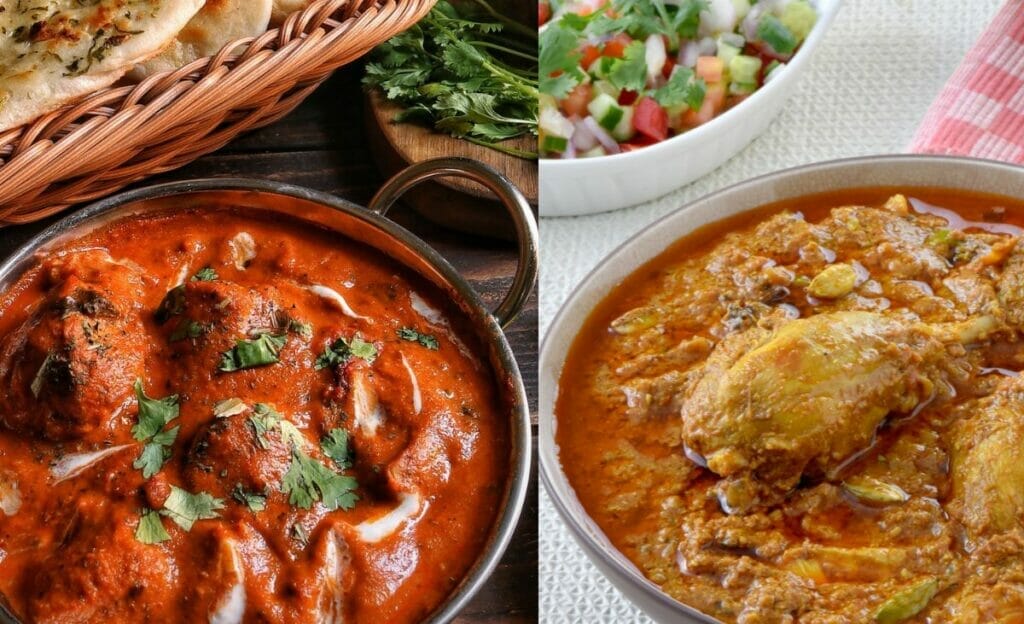
Another key difference lies in the chicken used to prepare these dishes.
In butter chicken, boneless chicken pieces, often breast meat, are commonly used. However, you can also use chicken thigh or both chicken breast and chicken thigh. The chicken is marinated to enhance its tenderness and flavor.
On the other hand, chicken korma traditionally features bone-in chicken, such as drumsticks or thighs. The bone-in pieces add depth of flavor and help create a succulent and moist texture when slow-cooked in the flavorful gravy.
Difference in Texture
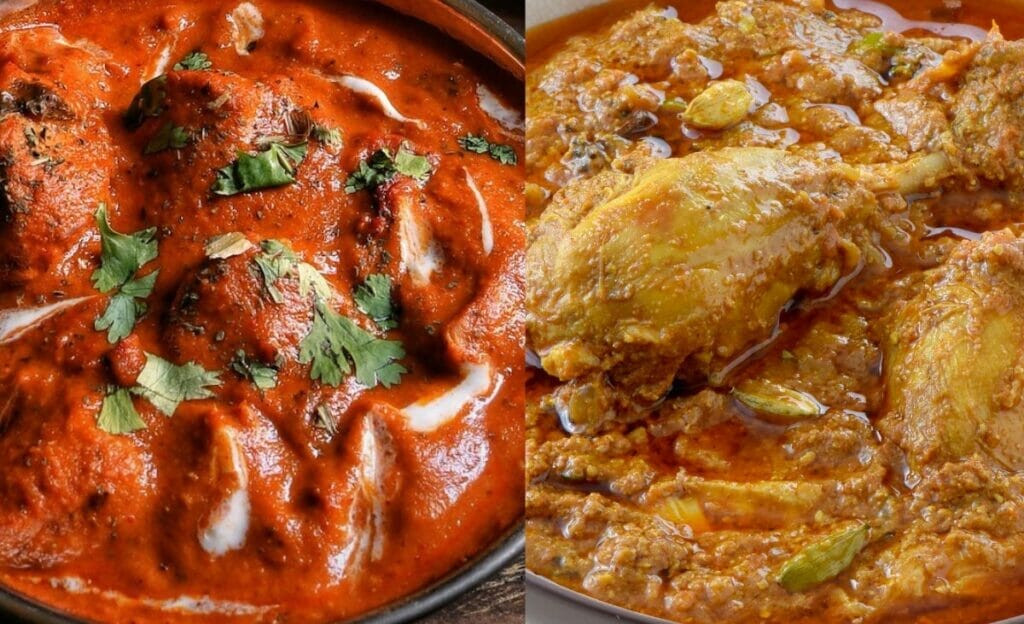
When it comes to texture, butter chicken and chicken korma offer distinct experiences.
Butter chicken showcases tender chunks of chicken that have been marinated and cooked to perfection.
The chicken pieces are often succulent and juicy, providing a satisfying bite. The creamy tomato-based gravy adds a smooth and velvety element, creating a harmonious combination of flavors and textures.
On the other hand, chicken korma offers a different texture profile. The slow cooking process allows the chicken to become incredibly grainy, tender, and succulent.
The bone-in chicken, often used in korma, adds depth of flavor and contributes to a moist and fall-off-the-bone texture.
The creamy and grainy gravy, enriched with yogurt, or ground nuts, and Barista (fried onion flakes) adds a luxurious and grainy element to the dish.
Difference in the Cooking Time
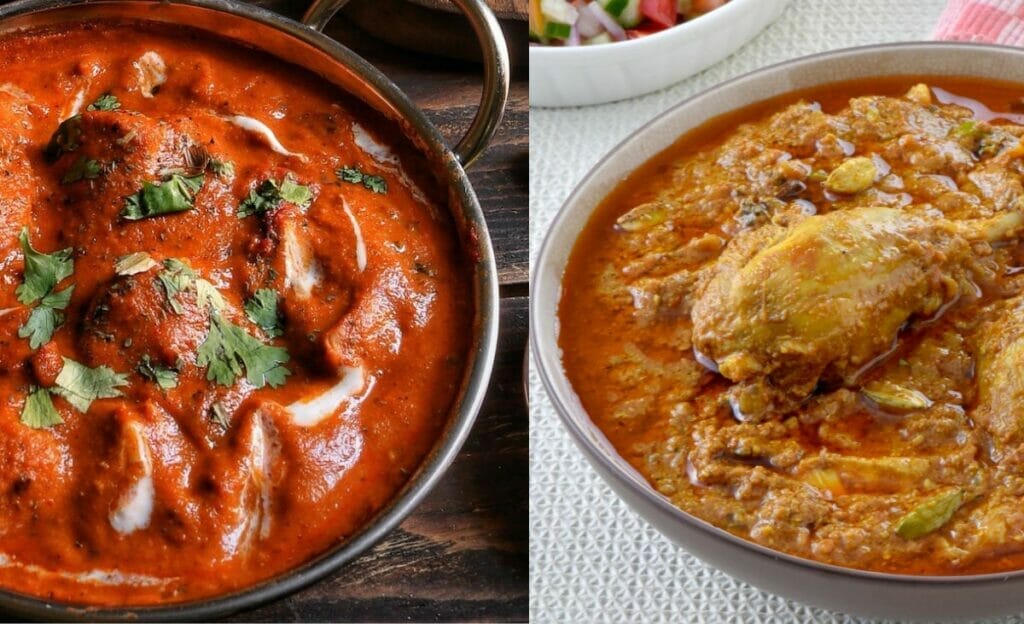
The cooking time for butter chicken and chicken korma can vary.
Butter chicken is typically prepared relatively quickly, making it a convenient choice for those seeking a flavorful meal in less time.
When it comes to Butter chicken the cooking time way less than the marination time. Ideally, to marinate the chicken, you should marinate the chicken overnight.
However, if you are in a hurry then you may marinate the chicken for as less as 30 minutes.
The cooking time can be between 20 to 30 minutes.
On the other hand, chicken korma requires a slightly longer cooking time to achieve its signature tenderness and melding of flavors.
The slow cooking method allows the spices and ingredients to infuse into the chicken and the gravy, resulting in a rich and aromatic dish.
Cooking chicken korma can take anywhere from 30 to 40 minutes to over an hour, allowing the flavors to develop and create a deeply satisfying taste.
Difference in the Method of Cooking

The method of cooking also sets butter chicken and chicken korma apart.
Butter chicken is often cooked in a pan on the stovetop or grilled, especially when the traditional tandoor oven is not available. Then added to the tomato-based gravy to simmer and absorb the flavors.
Chicken korma, on the other hand, is typically prepared using a slow-cooking technique. The chicken is gently simmered in the creamy gravy, allowing the flavors to meld together over low heat. This slow and patient cooking process ensures that the chicken becomes incredibly tender and allows the spices to infuse into every bite.
Difference in Serving Style
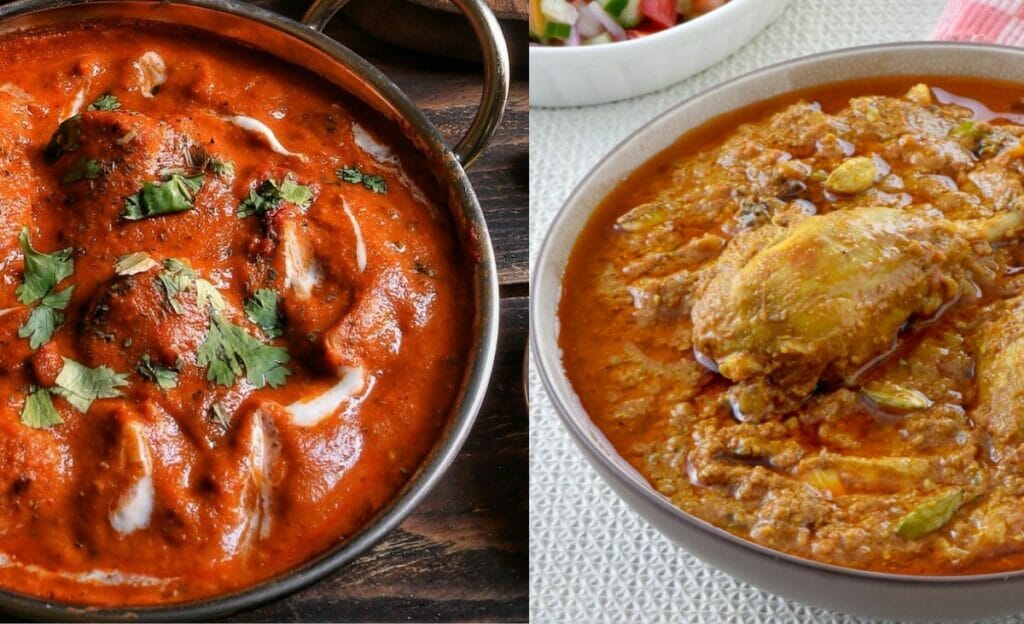
When it comes to serving, both butter chicken and chicken korma offer unique options to suit your preferences.
Butter chicken is often presented as a standalone dish, with the chicken and creamy gravy served together in a bowl or on a plate. It is commonly accompanied by naan bread or fragrant basmati rice, allowing you to soak up the delectable sauce and savor the flavors.
Chicken korma, on the other hand, is often served as part of a larger meal. It pairs wonderfully with a variety of Indian bread like roti or paratha, providing a delightful combination of textures and flavors.
Difference in Ingredients
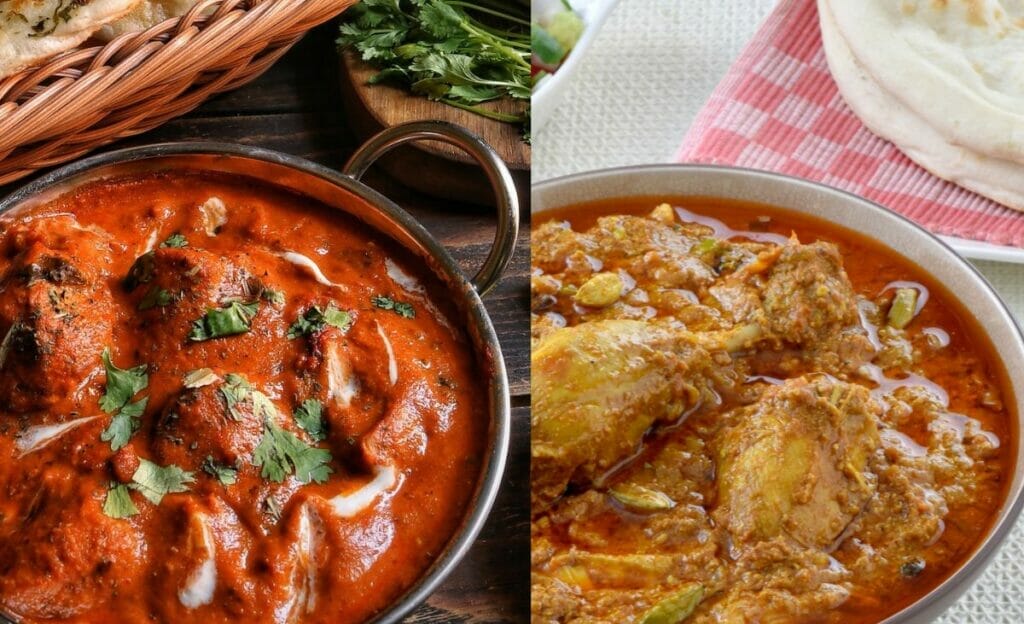
The ingredients used in butter chicken and chicken korma contribute to their distinctive flavors and characteristics.
In butter chicken, the key components include boneless chicken, tomatoes, onions, garlic, ginger, spices like garam masala, and a generous amount of butter and cream. These ingredients come together to create a creamy and tangy tomato-based gravy that envelops the tender chicken pieces.
Chicken korma, on the other hand, boasts a blend of ingredients that give it its unique identity. Along with the bone-in chicken, you’ll find a combination of yogurt, Barista (fried onion flakes), and cashews in the gravy.
Spices like cinnamon, cardamom, cloves, and nutmeg contribute to its distinct aroma and flavor profile. Together, these ingredients create a creamy and mildly spiced curry that is truly indulgent.
Difference in Nutritional Value
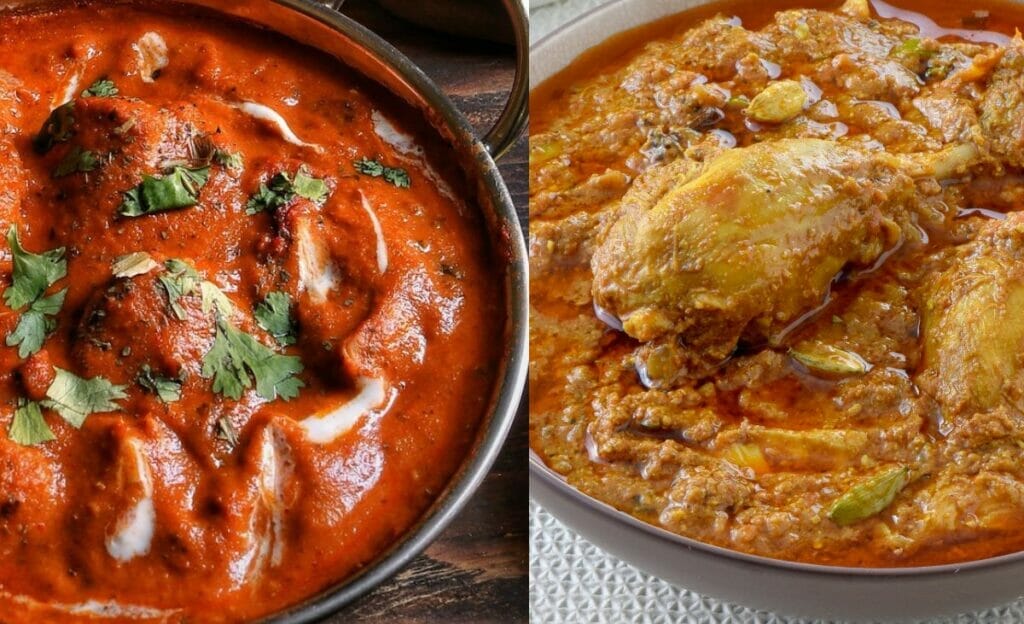
When considering the nutritional aspects of these dishes, it’s essential to take into account the variations in ingredients and cooking techniques.
Butter chicken, with its creamy base of butter and cream, tends to be higher in calories and fat. However, it is also a good source of protein from the chicken.
The nutritional values may vary based on the specific recipe and serving size, but a typical serving of butter chicken can contain around 400-500 calories, 20-30 grams of protein, and varying amounts of fat and carbohydrates.
Chicken korma, with its use of yogurt, cream, and ground nuts, also offers a rich and creamy experience. It tends to have a similar calorie content to butter chicken, ranging from 400-500 calories per serving.
However, the specific values may vary based on the recipe and serving size. Chicken korma, like butter chicken, provides a good amount of protein from the chicken.
It’s worth noting that the nutritional values of these dishes can be adjusted to suit individual dietary needs.
Lighter versions of both butter chicken and chicken korma can be made by using leaner cuts of chicken, reducing the amount of butter or cream, and incorporating healthier cooking techniques.
Are There Any Similarities Between Butter Chicken and Chicken Korma?
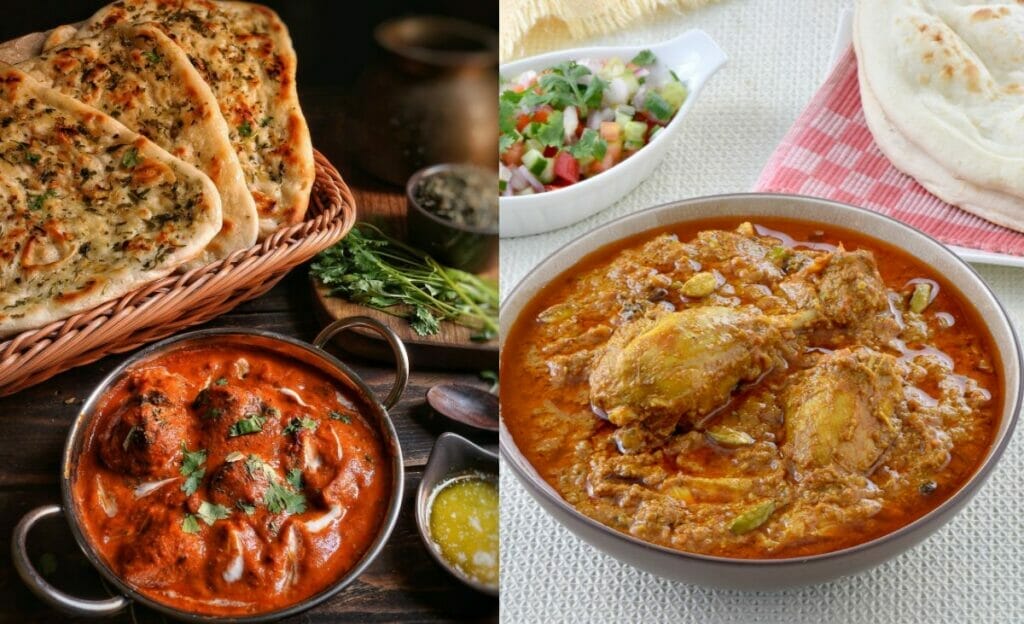
When it comes to comparing Butter Chicken and Chicken Korma, you might wonder if there are any similarities that connect them.
Despite their distinct flavors and characteristics, these dishes do share a few delightful commonalities.
Let’s dive into the similarities and discover the shared elements that make them both favorites on the menu.
Rich Gravies:
Both Butter Chicken and Chicken Korma feature luscious, tasty gravies that add a touch of indulgence to the dishes.
While the flavors may differ, the common thread of tasty and sumptuous sauces runs through both recipes.
Whether it’s the tangy tomato-based sauce of Butter Chicken or the luscious grainy sauce of Korma, both dishes are delicious.
Tender Chicken Pieces:
Another similarity between Butter Chicken and Chicken Korma lies in the use of tender chicken pieces.
While the specific cuts may vary, both dishes showcase succulent and well-marinated chicken. Whether you prefer boneless chicken breast in Butter Chicken or opt for bone-in pieces in Korma, the tender chicken takes on the flavors of the accompanying sauces, enhancing the overall experience.
Aromatic Spices:
Indian cuisine is renowned for its rich array of aromatic spices, and Butter Chicken and Chicken Korma are no exceptions.
Both dishes embrace a harmonious blend of spices that elevate the flavors.
While the spice profiles may differ, the careful selection and combination of spices create depth and complexity in both Butter Chicken and Chicken Korma.
Accompaniments:
In Indian cuisine, the art of enjoying a meal often involves pairing the main dish with delicious accompaniments.
Whether it’s a fluffy naan bread or fragrant basmati rice, Butter Chicken and Chicken Korma both lend themselves well to these complementary sides.
The combination of the creamy gravies with the bread or rice adds a delightful interplay of textures and flavors.
What is the difference between korma and tikka masala and butter chicken?

When it comes to Indian curries, it’s easy to get confused between korma, tikka masala, and butter chicken.
While they all share the common thread of being delicious chicken dishes, they each have their unique characteristics.
Korma is a grainy and mildly spiced curry, often enriched with yogurt, barista (fried onion flakes), and cashews.
Tikka masala, on the other hand, is known for its rich tomato-based gravy and smoky flavors from the use of tandoor-grilled chicken.
Butter chicken, also known as murgh makhani, features tender chicken pieces in a creamy and tangy tomato-based sauce, often with a hint of sweetness from butter and cream.
What does korma curry taste like?

Korma curry offers a delightful flavor profile. It is known for its grainy, rich, and nutty taste.
The combination of yogurt, barista (fried onion flakes), and cashews gives korma its grainy texture and luxurious flavors.
The spices used in korma, such as cinnamon, cardamom, and cloves, contribute to its mild warmth and aromatic notes.
Overall, korma curry is a harmonious blend of flavors that is both comforting and indulgent.
What is the difference between butter chicken and curry chicken?
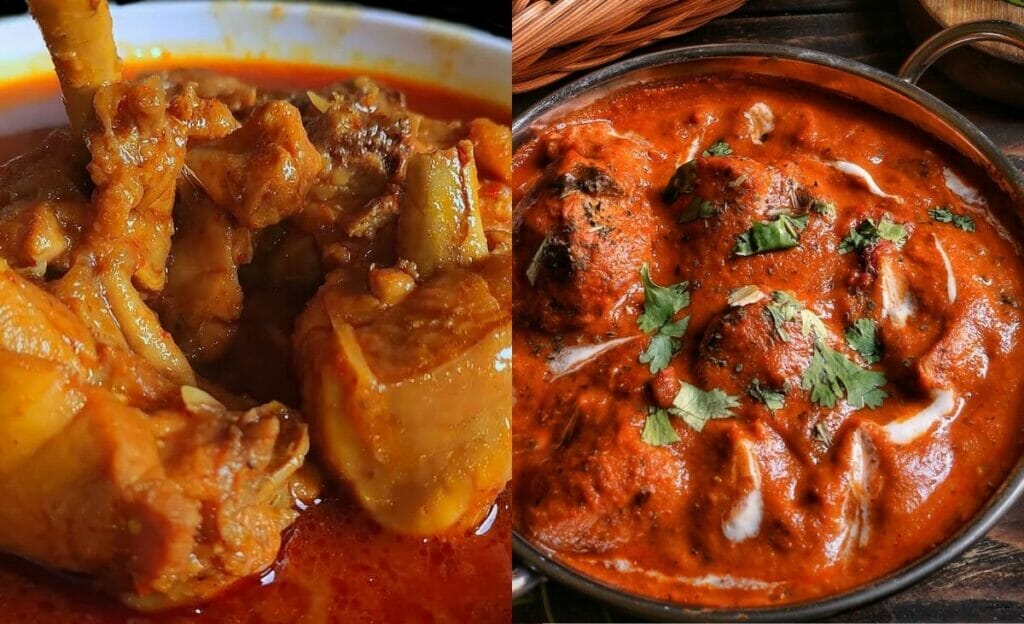
While butter chicken and curry chicken may seem similar, they have some distinct differences. Butter chicken, as mentioned earlier, is a specific dish that features tender chicken pieces in a creamy tomato-based sauce with butter and cream.
On the other hand, curry chicken is a broader term that refers to various chicken dishes prepared with a curry sauce. The curry sauce can have different bases, such as tomato, coconut milk, or yogurt, and the flavors can vary depending on the spices and ingredients used.
What’s healthier, korma or tikka masala?

When it comes to health, both korma and tikka masala can be enjoyed in moderation as part of a balanced diet.
However, if you’re looking for a slightly healthier option, korma may have the advantage.
Korma curry is generally milder in spice level and relies more on the richness from yogurt, barista (fried onion flakes), and cashews.
Tikka masala, while delicious, often includes a richer and more tomato-based gravy, which can potentially be higher in calories and fat content. A
s with any dish, it’s best to consider portion sizes and ingredients when making choices for your health.
Which tastes better, tikka masala or butter chicken?

The question of which tastes better, tikka masala or butter chicken, is subjective and depends on personal preference.
Tikka masala is known for its robust tomato-based sauce and smoky flavors from the tandoor-grilled chicken, making it a favorite for those who enjoy bold and tangy flavors.
On the other hand, butter chicken offers a creamy, tangy, and slightly sweet taste, making it a popular choice for those who appreciate a rich and indulgent dish.
Ultimately, the decision comes down to your individual taste buds and the flavor profiles that resonate with you the most.
Which is hotter, tikka masala or butter chicken?
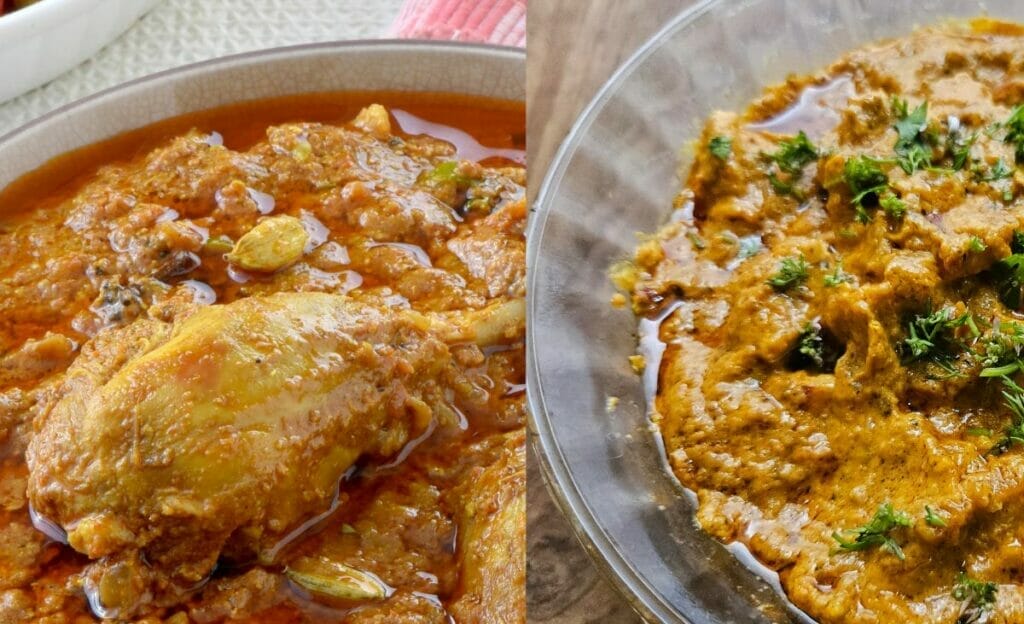
When it comes to spiciness, tikka masala and butter chicken can vary depending on the recipe and the chef’s preference.
Generally, tikka masala is known to have a bolder and spicier profile, with the potential for more heat from spices like chili powder and cayenne.
On the other hand, butter chicken tends to be milder in terms of spiciness, with a focus on creamy and tangy flavors.
However, it’s important to remember that spice levels can be adjusted to suit individual preferences, so you can always request a milder or spicier version of either dish.
Chicken korma vs. chicken curry
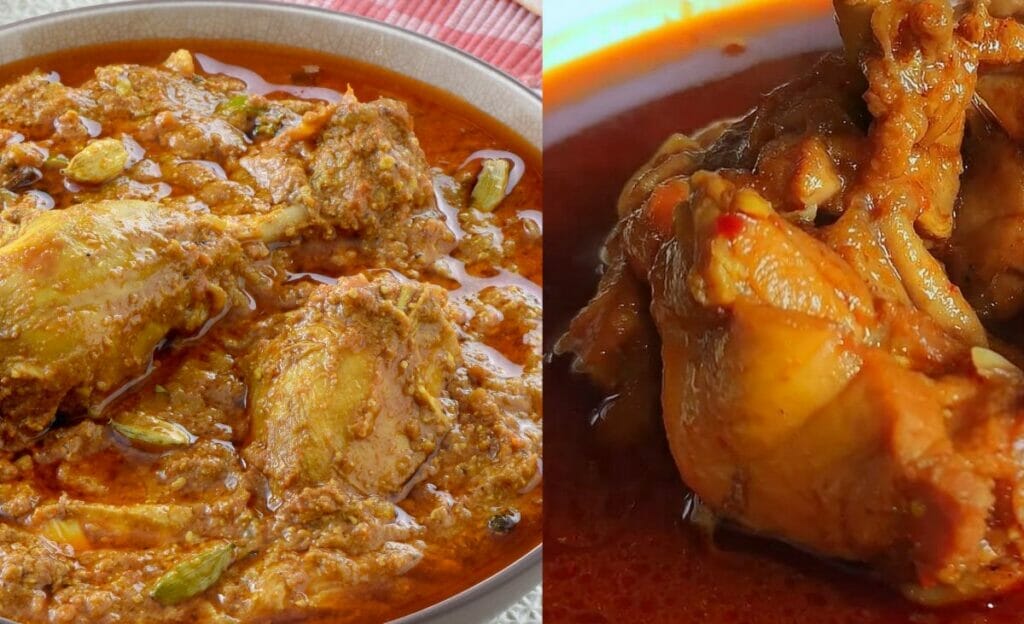
When comparing chicken korma and chicken curry, it’s essential to recognize that chicken curry is a broader term that encompasses various styles and regional variations. Chicken curry can be prepared in a multitude of ways, incorporating different spices, ingredients, and cooking techniques.
On the other hand, chicken korma refers specifically to a creamy and mildly spiced curry enriched with yogurt, barista (fried onion flakes), and cashews.
The distinction lies in the creaminess and luxurious texture of korma, setting it apart from other chicken curry preparations.
Is butter chicken healthy or unhealthy?

Butter chicken, while incredibly delicious, is not typically considered a “healthy” dish due to its higher calorie and fat content.
The dish often contains butter, cream, and sometimes even additional oil or ghee, which contribute to its rich and indulgent nature.
However, it can still be enjoyed in moderation as part of a balanced diet.
To make a healthier version of butter chicken, you can opt for leaner cuts of chicken, reduce the amount of butter and cream, and incorporate healthier cooking techniques such as baking or grilling.
Is korma good for health?
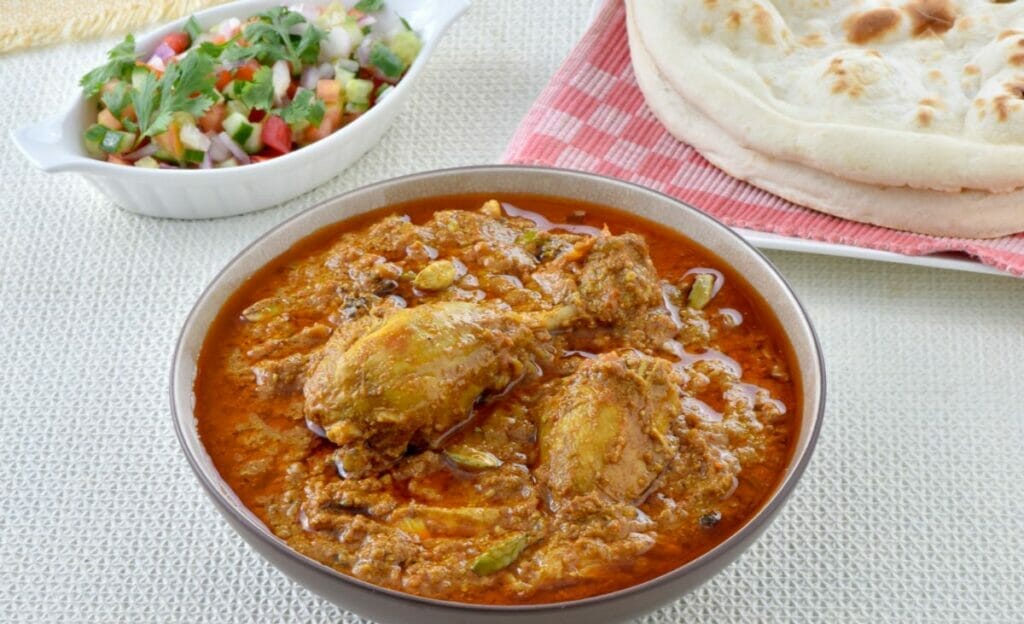
Korma, like any dish, can be enjoyed as part of a balanced diet. While it offers a creamy and flavorful experience, it’s important to be mindful of portion sizes and the overall balance of your meals.
The use of yogurt, barista (fried onion flakes), and cashews in korma adds richness, which can contribute to its calorie and fat content.
However, korma also provides protein from the chicken and can be packed with nutritious spices and ingredients.
If you’re watching your calorie intake, you can make lighter versions of korma by using leaner cuts of chicken and moderating the amount of cream or nuts used.
Which is spicier, butter chicken, or chicken korma?

Between butter chicken and chicken korma, the spiciness can vary depending on the recipe and personal preference.
In general, butter chicken tends to be milder in terms of spice, focusing more on the creamy and tangy flavors.
Chicken korma, on the other hand, can have a mild to moderate level of spiciness, depending on the amount and types of spices used.
However, it’s worth noting that the spice levels can be adjusted to suit individual tastes, so you can request a spicier or milder version of either dish.
Which is healthier, butter chicken or chicken korma?
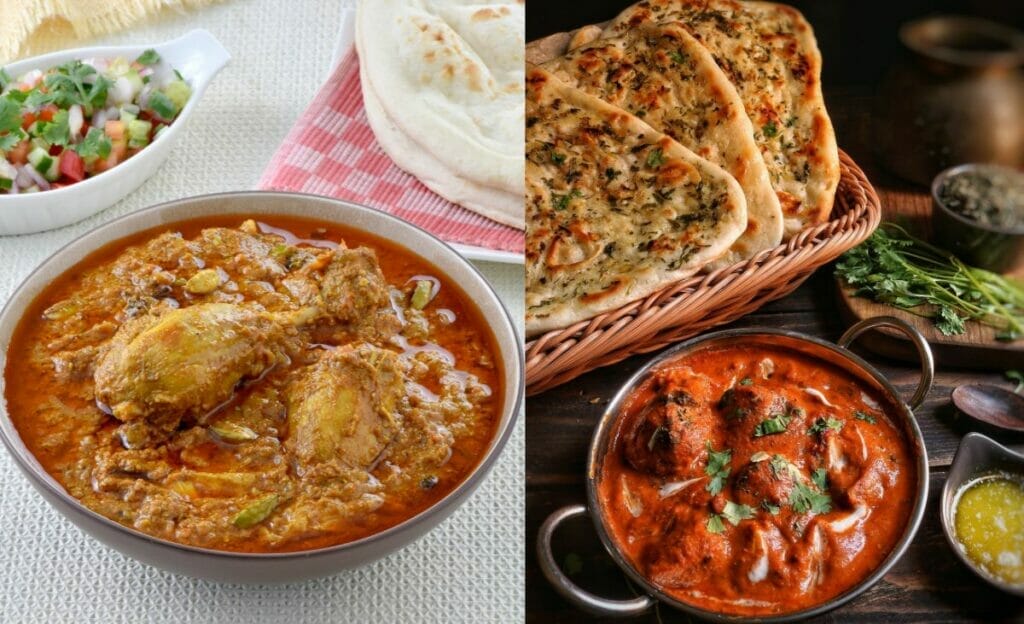
In terms of healthiness, both butter chicken and chicken korma can be enjoyed in moderation as part of a balanced diet.
However, if you’re looking for a slightly healthier option, chicken korma may have the advantage.
While both dishes can contain ingredients like butter, barista (fried onion flakes), and cashews, korma typically has a milder spice profile and relies more on the creaminess from yogurt and nuts for flavor.
Butter chicken, with its creamy tomato-based sauce, may be slightly higher in calories and fat content. As always, portion control and ingredient choices play a significant role in the overall healthiness of any dish.
Which is better, butter chicken or chicken korma?
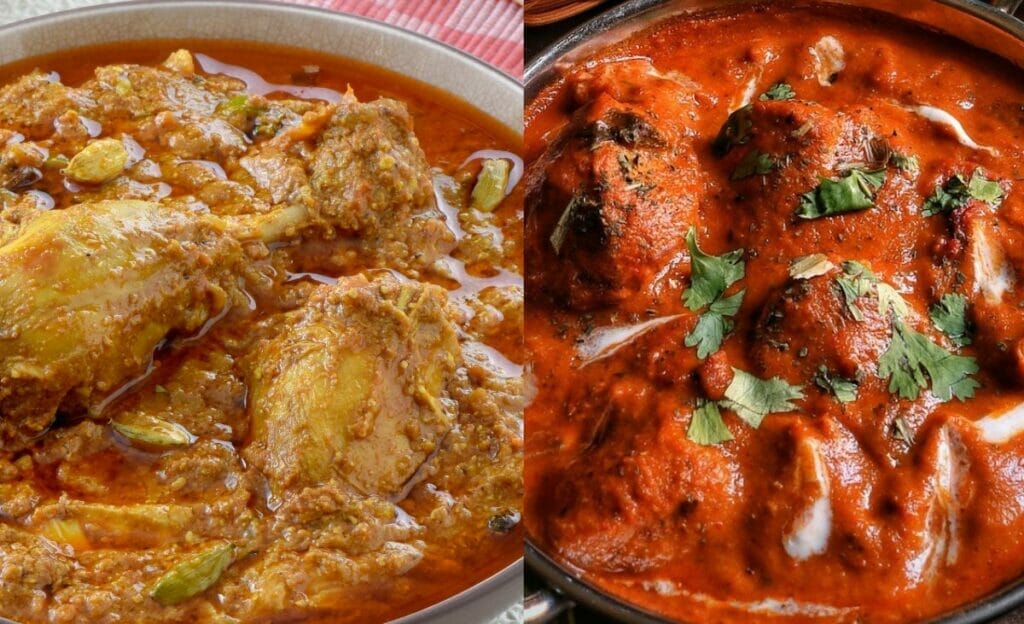
Choosing between butter chicken and chicken korma ultimately comes down to personal preference.
Butter chicken offers a creamy, tangy, and slightly sweet flavor profile, making it a favorite for those who enjoy rich and indulgent dishes.
On the other hand, chicken korma delivers a creamy and mildly spiced experience, with its nutty undertones and luxurious texture.
Both dishes have their unique charm and can be incredibly satisfying when prepared well. Whether you lean towards the tanginess of butter chicken or the subtle warmth of korma, you’re in for a treat either way!
Conclusion
In conclusion, the battle between Butter Chicken and Chicken Korma is a delightful one, as each dish brings its own unique flavors and characteristics to the table.
From the creamy and tangy notes of Butter Chicken to the nutty and mildly spiced indulgence of Chicken Korma, both dishes offer a culinary experience that is hard to resist.
Throughout the article, we’ve explored the key differences and similarities between these two Indian classics, ranging from their origins and flavors to the choice of ingredients and nutritional value.
We’ve also delved into the intriguing comparisons with other popular dishes like Tikka Masala and Curry Chicken and discussed aspects such as spiciness, cooking methods, and serving styles.
If you’re a food enthusiast looking to discover new flavors or expand your knowledge of Indian cuisine, this article provides valuable insights into the world of Butter Chicken and Chicken Korma.
Whether you’re seeking a tangy and creamy delight or a rich and mildly spiced indulgence, these dishes offer a culinary adventure worth exploring.
So, grab a plate of piping hot Butter Chicken or a bowl of fragrant Chicken Korma, and let your taste buds embark on a journey through the vibrant and aromatic landscape of Indian flavors. Don’t miss out on the fascinating details we’ve covered, from the differences in texture and cooking time to the nutritional aspects and comparisons with other popular dishes.
Related articles:
- Butter Chicken vs Chicken Marsala: A Clash of Culinary Titans
- Tikka Masala vs Butter Chicken: What’s the Difference and Which One Is Better?
- Butter Chicken vs Indian Chicken Curry (From Creamy to Spicy)
- Butter Chicken vs Tandoori Chicken (Exploring the Contrasts)
- Butter Chicken vs Kadai Chicken (Unraveling the Flavors of India)
- Butter Chicken vs. Chicken Vindaloo (Unveiling the Differences)
- Butter Chicken vs Kashmiri Chicken (Decoding the Delicacies)
- Chicken Tikka Masala vs Chicken Korma (Exploring Indian Cuisine)
- Chicken Masala vs Butter Chicken: Decoding the Spice Symphony
- Chicken Korma vs Chicken Curry: Diverse Indian Delicacies
- Chicken Korma vs Chicken Karahi: A Tale of Two Curries
- Chicken Masala vs Chicken Korma: Decoding the Spice Symphony
- Chicken Korma vs Chicken Vindaloo Comparison: Beyond Spice
